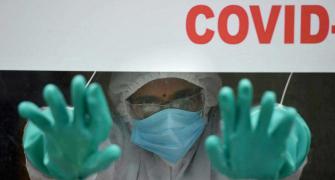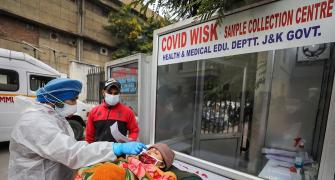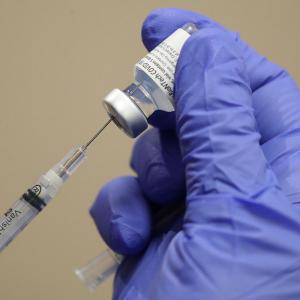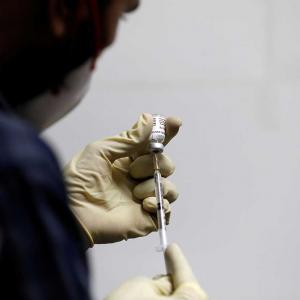'Even after vaccines are given, precautions like using a mask and maintaining social distancing have to be taken.'

India is getting ready to vaccinate its people against COVID-19 from January.
The plan is to vaccinate 300 million people in one year.
The advantage that India has is its vaccine manufacturing capacity.
The Serum Institute of India in Pune is manufacturing the Oxford-AstraZeneca and Novavax vaccines.
The Russian Sputnik V vaccine is being manufactured by Dr Reddy's Lab in Hyderabad.
Bharat Biotech has entered Phase 3 clinical trials of Covaxin.
But many people are anxious about vaccinating themselves because of many misconceptions.
"In the case of this vaccine, since it has not been tested for a long period in the human population, we have to be a little more careful," Dr Shahid Jameel, the well known virologist who is director of the Trivedi School of Biosciences at Ashoka University, tells Shobha Warrier/ Rediff.com in the second of a two-part interview.

Reports about the allergic reaction after taking the Pfizer vaccine in the UK and US have made many people apprehensive.
Should we be worried?
Of course, people would be worried.
But it is the job of the press to set aside these fears.
Unfortunately, some irresponsible press is amplifying it.
We never spoke about the allergic reactions of the flu vaccine or the measles vaccine.
The fact is, all vaccines have some level of allergic reaction in some people.
But the press is amplifying it and all kinds of conspiracy theories are floating around.
This will increase the doubts in the minds of those who do not understand these issues well.

You feel the press should be more careful while reporting such sensitive issues?
Absolutely. The press has to understand what they are writing about.
Most of the time, I feel that press doesn't understand what they are writing about.
A friend of mine commented that to many reporters, the RNA vaccine and chyavanprash are the same thing.
To a large extent, it is true.
Science journalism in the country hasn't developed at all.
People who are reporting on the elections and economy are writing about covid too!
They don't understand the scientific method and are not trained to write about science.
Even politicians indulge in spreading wrong information.
The other day, the Brazilian president said that if you can take the vaccine, men would become crocodiles and women would grow beard!!!
There is no dearth of stupid people in the world!
A country's president also can be stupid!
Just because they are leaders, they don't become wise.
 IMAGE: Katalin Kariko, the Hungarian biochemist.Photograph: Kind courtesy Krdobyns/Wikipedia.org
IMAGE: Katalin Kariko, the Hungarian biochemist.Photograph: Kind courtesy Krdobyns/Wikipedia.orgDo you feel the Hungarian scientist Katalin Kariko's pioneering work using mRNA to fight a disease which is used in the vaccines is something revolutionary?
Yes, the concept is new.
What every vaccine tries to do is, either presents a killed or attenuated (or weakened) pathogen to the immune system, or it tries to produce pathogen proteins within our body so that our body can make antibodies and develop other types of immune responses.
These proteins can be made by delivering either pathogen DNA or RNA directly or via viral vectors such as Adenoviruses.
In case of the COVID-19 RNA vaccines, the RNA coding for the viral spike protein is injected into the body, so that it will make the protein.
The DNA which contains the code for making proteins, cannot directly make proteins.
The DNA has to be converted into a copy and that copy is the RNA which translates to make proteins.
So, instead of sending the DNA, if you send the RNA, you are reducing one step in the process.
But the problem with the RNA is that it is a very labile molecule which degrades very quickly.
The technology is not about making the RNA; it is about protecting the RNA before it degrades.
So, the scientists came up with a kind of particle made up of fat molecules (called lipids) in which they can package and protect the RNA, and then give it as a vaccine to the cells.
The cells can translate it to make protein.
It is a simple and new technology, but it is a technology for future.

The advantage of using the RNA vaccine is that it has no vector background.
On the other hand, if we use the viral vector for example, it has a small piece of pathogen DNA but large amounts of viral vector DNA.
It will make the pathogen protein but also a lot of vector protein.
The body will raise antibodies to both.
The adenovirus vaccines that are being developed, including the Serum Institute one, can be given only once.
You cannot use the same vector to give another vaccine.
For example, anyone who has received an adenovirus vaccine for SARS 2, will not be able to take an adenovirus vaccine for another pathogen.
Our body will very quickly kill the virus vector because our body is already immune to it.
But RNA technology doesn't suffer from this because all you are doing is sending a piece of RNA to make the protein.
So, you can send an RNA to make a protein for SARS 2 and later for another pathogen.
You can use the same technology over and over again by simply replacing the RNA while you can't do that for vectors.
For vectors, you have to inject an entirely new vector.
That's what is great about this technology.

It is said that after vaccination, the person has to sit there for 30 minutes to monitor for any reaction.
Is it going to be a very time-consuming exercise to vaccinate such a huge population?
It won't be.
You just sit there for 30 minutes and if you show any reaction, you will need attention.
Most people won't show any reaction and they can go home.
But this is the protocol that is followed for every vaccine.
In the case of this vaccine, since it has not been tested for a long period in the human population, we have to be a little more careful.

There are quite a few covid vaccines available in the world now.
Which one will be suited for Indian conditions?
Of course, because Pfizer requires -70 degrees storage, it is ruled out...
Yes, Pfizer and Moderna require cold storage, and our distribution system is not meant for that.
Further, those vaccines are not yet available for India.
Another question is, will we be able to afford a vaccine that is $20-$35 a dose?
But India is in a good situation because five different vaccines are in human trials, of which three are already in Phase 3.
They are likely to show decent efficacy.
We have to also understand that it is not just efficacy that is important, but also the coverage of the vaccine.
That is, how many people can you give it?
You can have a vaccine that is 95% efficacy, but if you can only give it to 100 people in the country, what is the use?
On the other hand, you have a vaccine like the Covaxin or the Serum Institute vaccine, even if those vaccines are 80% efficacious, it will still be better than a 95% efficacious vaccine which has poor coverage.
And the government is planning to vaccinate 300 million people by the end of 2021.
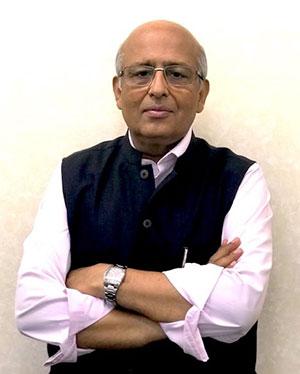 IMAGE: Dr Shahid Jameel.
IMAGE: Dr Shahid Jameel.It was reported that India was going to be the biggest buyer of covid vaccines with 1.6 billion doses booked....
Actually, India has not booked these many doses.
Because these large vaccine companies are manufacturing in India, they are committed to reserve some vaccines for India.
To my knowledge, India has not given any money to these companies to make vaccines, but there is the promise to buy millions of doses.
Many scientists say we have to vaccinate at least 70% of the population to effectively subjugate the virus, which means we need many doses...
Yes, we can vaccinate around 800 million people with 1.6 billion doses.
I don't think capacity is the issue.
The challenge is going to be whether we have facilities to store that many doses, whether we have enough trained manpower to inject that many doses.
How long do you think it will take to cover 60%-70% of the population?
At present, we are not talking about 60%-70% of the population.
We are only talking about 30 crore (300 million) people in the next 12 months.
And you may not even need after that.

Herd immunity?
It could be herd immunity.
There will be enough people infected asymptomatically who will not need a vaccine.
But if you were to give the vaccine to 800 million people, it will take about 3 years to do that.
But something we have to look out for after vaccinating 300 million people is, whether there are any vaccine-escape viral variants coming up.
We do not know whether the viruses will mutate in response to the vaccine.
There will be that selection pressure on viruses too.
So, if in future, any mutant virus emerge that can bypass the vaccine, that variant will spread really quickly even in vaccinated people.
What I mean is, surveillance cannot go down simply because the curve is going down.
Even after vaccines are rolled out and given, precautions like using a mask and maintaining social distancing have to be taken.
For one more year?
Until WHO declares the pandemic is over.
In what order should we vaccinate people?
The government has a sensible plan -- 30 crore people in the first lot -- 1 crore healthcare workers, 2 crore (20 million) other frontline workers and 27 crore (270 million) those most as risk of severe disease -- those over 50 years of age and those below 50 years with comorbidities.
Beyond that, we should go with pockets of dense population with the highest risk of infection -- large urban centres, especially urban slums.
Feature Presentation: Ashish Narsale/ Rediff.com


